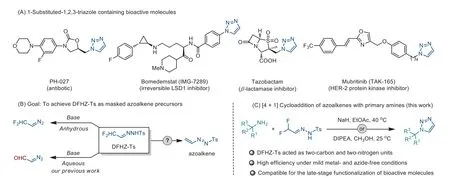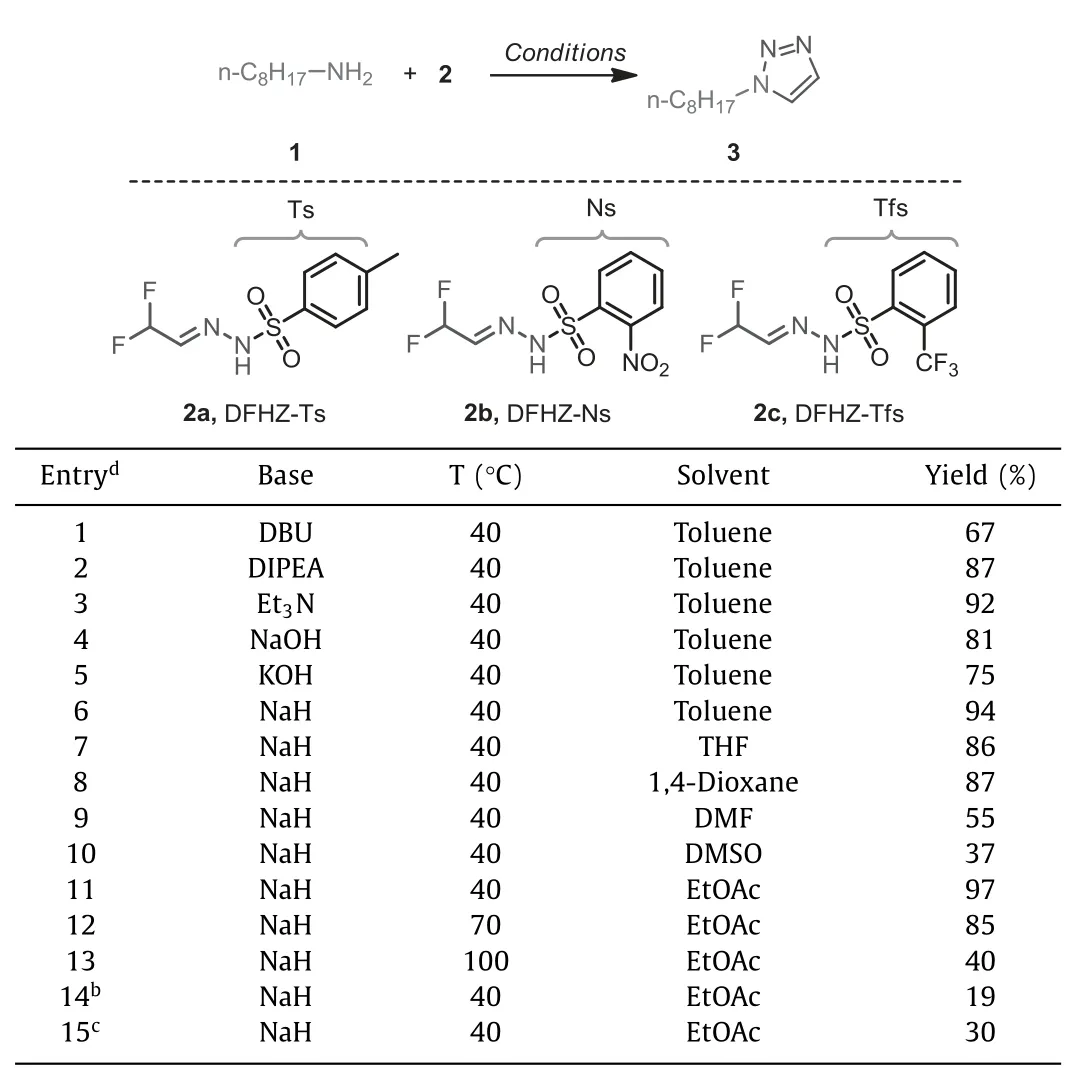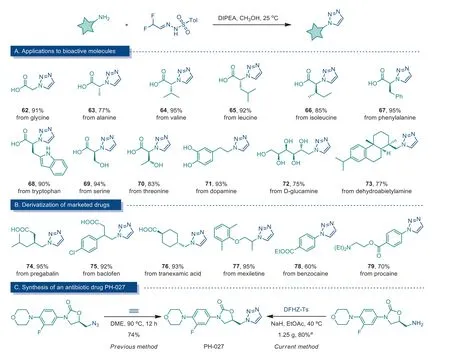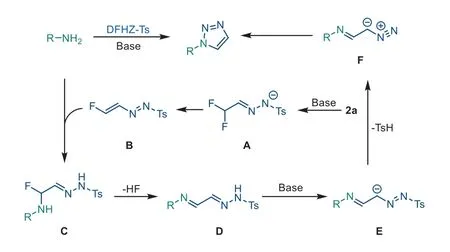[4+1]Annulation of in situ generated azoalkenes with amines:A powerful approach to access 1-substituted 1,2,3-triazoles
Hongwei Wng,Yongqun Ning,Prmsivm Sivguru,Giuseppe Znoni,Xihe Bi,c,∗
a Department of Chemistry,Northeast Normal University,Changchun 130024,China
b Department of Chemistry,University of Pavia,Viale Taramelli 12,Pavia 27100,Italy
c State Key Laboratory of Elemento-Organic Chemistry,Nankai University,Tianjin 300071,China
Keywords:[4+1]Annulation Azoalkene Late-stage functionalization 1-Substituted 1,2,3-triazoles
ABSTRACT 1-Substituted 1,2,3-triazoles represents ‘privileged’structural scaffolds of many clinical pharmaceuticals.However,the traditional methods for their preparation mainly rely on thermal [3+2]cycloaddition of potentially dangerous acetylene and azides.Here we report a base-mediated [4+1]annulation of azoalkenes generated in situ from readily available difluoroacetaldehyde N-tosylhydrazones (DFHZ-Ts)with amines under relatively mild conditions.This azide- and acetylene-free strategy provides facile access to diverse 1-substituted 1,2,3-triazole derivatives in high yield in a regiospecific manner.This transformation has great functional group tolerance and can suit a broad substrate scope.Furthermore,the application of this novel methodology in the gram-scale synthesis of an antibiotic drug PH-027 and in the late-stage derivatization of several bioactive small molecules and clinical drugs demonstrated its generality,practicability and applicability.
1-Substituted-1,2,3-triazoles represent an important fivemembered aza-heterocycles,widely present in bioactive compounds and clinical pharmaceuticals (Fig.1A) [1–5].As a result,these aza-heterocycles have gained the attention as attractive synthetic targets for the development of new chemical reactions.In 1910,Dimroth and Fester first reported the synthesis of 1-phenyl-1,2,3-triazoles by heating phenyl azide with acetylene-saturated acetone in a sealed pipe [6].Since then,several analogous reactions have emerged using various acetylene derivatives [7–9],such as acetylides [10–20]and vinyl derivatives [21–25].While these works stand out as pioneering efforts,wide applications of these methods are hindered by drawbacks,such as requiring high pressure and specialized apparatus to handle potentially dangerous acetylene gas [26],toxic and explosive azides [27,28],high temperatures,narrow substrate scope and unsatisfactory yields [6–25].Therefore,the development of a reliable and practical method for the synthesis of 1-substituted 1,2,3-triazoles is quite appealing.
In this context,the [4+1]annulation ofN-sulfonylhydrazones with primary amines (which are readily-available building blocks)[29–32]provides an efficient entry to access various substituted 1,2,3-triazoles [33–43].Nevertheless,high temperature and strong basic or acidic conditions [44]of the process limit the substrate scope and functional group tolerance,including the late-stage functionalization of complex bioactive molecules[33–44].In the framework of our continuous interest in the preparation and applications of fluoroalkylN-sulfonylhydrazones[45–49],we have recently discovered difluoroacetaldehydeNtriftosylhydrazones (DFHZ-Tfs) as an operationally simple and bench-stable difluoroalkyl diazo surrogate in carbene transfer reactions.Notably,we observed that DFHZ-Tfs could undergo basemediated defluorination into diazoacetaldehyde (CHOCHN2) under aqueous conditions (Fig.1B) [50].Intrigued by this finding,we envisioned that the introduction of a reactive nucleophile in the base-mediated reaction of difluoroacetaldehydeN-tosylhydrazones(DFHZ-Ts) would achieve a similar type of C-F bond activation,leading to the discovery of a new reactivity mode of DFHZ-Ts as masked azoalkene equivalent in [4+1]annulation with primary amines.Herein,we disclose the successful introduction of this strategy and present a convenient method for the synthesis of 1-substituted 1,2,3-triazolesvia[4+1]annulation ofin situgenerated azoalkene from DFHZ-Ts with primary amines (Fig.1C).In contrast to earlier reports,this [4+1]annulation process eliminates the need for potentially dangerous acetylene gases and specialized apparatus,azides,and high pressure and temperatures [6–44].This mild protocol proved to be amenable to a broad range of alkyl and aryl primary amines with different functionalities and scale-up.The method was also successfully applied to the latestage functionalization of complex bioactive molecules and clinical drugs.

Fig.1.Inspiration towards the synthesis of 1-substituted 1,2,3-triazoles.(A) Examples of bioactive molecules containing 1-substituted 1,2,3-triazole moiety.(B) Different reactivity modes of DFHZ-Tfs.(C) This work: DFHZ as an azoalkence equivalent in the [4+1]annulation with primary amines.
We initiated our studies by exploring the reaction conditions for the model reaction ofn-octylamine (1) and DFHZ-Ts (2a).The initial reaction with the use of DBU as a base in toluene at 40°C afforded the corresponding product 3 in 67% yield (Table 1).Of all bases screened (e.g.,DIPEA,Et3N,NaOH,CsOH,KOH,and NaH),NaH was found to be the optimal base,giving 3 in 94% yield (entries 1-5vs.6).A brief survey of reaction media showed that ethyl acetate was the best solvent,which gave 3 in 97% yield.Other solvents,such as THF,1,4-dioxane,DMSO and DMF,produced the desired product 3 in lower yields (entries 7-10vs.11).The product yield was significantly reduced when conducting the reactions at elevated temperatures due to the competitive diazo coupling of DFHZ-Ts (entries 12 and 13).However,reactions with otherNsulfonylhydrazones 2b and 2c led to poor yields (entries 14,15).

Table 1 Optimization of reaction conditions.a
With the optimized conditions in hand,the generality of the method was investigated (Scheme 1).We found that the method is suitable for diverse aliphatic amines,such as linear (n-octyl,n-butyl),branched (isopropyl,tert-butyl),and cyclic amines (cyclopropyl,cyclopentyl,cyclohexyl,cyclooctyl,2-aminotetralin),affording desired 1,2,3-triazoles (3–11) in 73%–97% yield.Additionally,benzylic,heterobenzylic,and homobenzylic amines,even bearing anα-branching,could also be employed for annulation reaction to form corresponding products (12–18) in 85%–97% yield.α-Branched amines are the core structures of many approved pharmaceuticals [51,52].Converting them into triazoles might enhance their bioactivity.Notably,aliphatic amines with multiple functionalities,including cyclopropyl,tetrahydropyranyl,pyrrolidinyl,morpholinyl,chloro,azido,difluoromethyl,hydroxyl,ether,thioether,acid,ester and amides at the terminus of the alkyl chain remained intact,providing the desired products (19–32) in 61%–97% yields.Likewise,alkene-,and alkyne-containing amines could also be tolerated in the transformation with high yields (33–36,85%–95%),demonstrating the synthetic advantages of this method.To our gratification,optically active chiral amine,amino alcohols and amino ester were reacted smoothly to afford the corresponding triazoles (37–41) in excellent yield without loss of optical purity [53–55].These kinds ofα-N-chiral triazoles are difficult to synthesizeviaa traditional alkyne–azide cycloaddition process [56–58].This method can also be used to build di- and trimeric 1,2,3-triazole products.As shown in Scheme 2B,meso-1,2-diphenylethylenediamine,1,6-hexanediamine,1,12-dodecanediamine,1,8-diamino-3,6-dioxaoctane,and tris(2-aminoethyl)amine provided the desired dimeric (42–45) and trimeric (46) triazoles in generally high yields.Such polymeric 1,2,3-triazoles could be used as potentially effective copper(I)-stabilizing ligands in catalysis [59,60]and in material science [61].The method is also suitable for a range of aromatic amines,including electron-rich and electron-poor aromatic amines,to give the corresponding 1-aryl-1,2,3-triazole products (47–55) in good to excellent yields.Notably,we found that the electron-rich arylamines afforded the desired products in higher yields than electron-poor arylamines and needed a higher temperature to complete the reaction.It is worth noting that 4-vinyl- and 4-ethynylaniline underwent [4+1]annulation chemoselectively to give desired triazoles (56 and 57) in high yields without interfering with the more electron-deficient vinyl and ethynyl groups.In addition,the multisubstituted substrate could be tolerated under this standard condition,affording desired product (58) in 82% yield.Moreover,polycyclic (hetero)aromatic structures such as naphthalene,fluorene,and pyridine on amines could also be tolerated in the transformation with good yields (59–61).The structure of the compound (60)was unambiguously confirmed by single-crystal X-ray crystallography (CCDC number: 2026985).

Scheme 1.Substrate scope for the synthesis of 1-substituted 1,2,3-triazole.Reaction condition: amine (0.2 mmol,1.0 equiv.),DFHZ-Ts (0.2 mmol),and NaH (0.6 mmol,3.0 equiv.),in 2 mL of EtOAc at 40 °C for 1,2 h under air.a DIPEA (1.2 mmol) in 2 mL of MeOH.b Reaction conducted at 60 °C.Isolated yields.
The unusual functional group tolerance of the process under mild reaction conditions makes this method may be highly useful to access otherwise challenging products in late-stage functionalization to probe this potential,a series of structurally complex small bioactive molecules and clinical drugs were applied.As depicted in Scheme 2,a large range of amino acids,such as glycine,alanine,valine,leucine,isoleucine,phenylalanine,tryptophan,serine,and threonine were all annulated smoothly with DFHZ-Ts in the presence of DIPEA in MeOH,giving rise to 1,2,3-triazole-1-acetic acid derivatives (62–70) in 77%–95% yields.Similarly,dopamine (a type of neurotransmitter),D-glucamine (an amino sugar),and dehydroabietylamine (a complex natural product) could all compatible in the transformation with good yields(71–73).Remarkably,a range of marketed drugs,including pregabalin (LyricaTM,an anti-seizure drug),baclofen (LioresalTM,a muscle relaxer and an antispasmodic agent),tranexamic acid (used to treat or prevent excessive blood loss from major trauma,surgery,and heavy menstruation),all bearing a carboxylic acid group,were annulated smoothly in excellent yields (74–76).Mexiletine (used to treat abnormal heart rhythms) could also be converted to give desired triazole product (77) in 95% yield.Moreover,commonlyused anesthetic drugs such as benzocaine (Orajel) and Procaine(a local anesthetic drug) were also successfully generated the annulated products (78 and 79) in 60% and 70% yields,respectively (Scheme 2B).PH-027 is a potent antimicrobial drug against sensitive and resistant gram-positive aerobic bacteria.However,the reported method for its preparation needs a multi-step process utilizing toxic and explosive azides,acetylene gas and relatively harsh reaction conditions (2).By using our newly developed method,PH-027 can be prepared readily on a gram scale from corresponding amine,(5R)-5-(aminomethyl)-3-(3-fluoro-4-morpholin-4-ylphenyl)-1,3-oxazolidin-2-one in a single step with 80% yield(Scheme 2C).Notably,this method offers a practical solution to address the above-mentioned issues of the previous method.Overall,the ready availability of the substrates,broad scope,excellent functional group tolerance,and mild conditions make this approach become a practical candidate for late-stage functionalization of structurally complex bioactive small molecules and marketed drugs.
To gain insights into the reaction mechanism of this [4+1]annulation,control experiments were performed as shown in Scheme 3.The addition of preformed CF2HCHN2to the standard reaction conditions led to no reaction,which excludes the possibility of CF2HCHN2as an intermediate of this transformation(Scheme 3a).No reaction was observed when treating ethyl fluoroacetate with aniline under standard conditions (Scheme 3b).

Scheme 2.The late-stage functionalization of complex bioactive molecules and clinical drugs.Reaction conditions: Amine (0.2 mmol),DFHZ-Ts (0.2 mmol),and DIPEA(1.2 mmol) in 2 mL of MeOH at r.t.for 3–5 h under air.a 5.0 mmol scale.Isolated yields.

Scheme 3.Mechanistic studies and control experiments.

Scheme 4.Proposed reaction mechanism.
Based on the above control experiment results and previously reported mechanistic proposals [50,62–64],a possible mechanism of the reaction was proposed (Scheme 4).Initially,the active intermediate azoalkene B was formed through the base-promoted activation of C-F bond of 2a.The 1,4-aza conjugate addition of an amine to azoalkene B generates intermediate C,which then eliminates the second molecule of HF,giving rise to intermediate D.Next,intermediate F was formed from Dviaintermediate E with the release ofp-toluenesulfonic acid.Finally,the intramolecular cyclization of intermediate F provides the desired annulation product 3.
In conclusion,we have demonstrated the new reactivity mode of difluoroacetaldehydeN-tosylhydrazones (DFHZ-Ts) as masked azoalkene equivalent in the [4+1]annulation with primary amines.This operationally simple and safe protocol provides easy access to diverse 1-substituted 1,2,3-triazoles under metal-,azideand acetylene-free conditions.Operational simplicity,easy availability and stability of the reagents,mild reaction conditions,and tolerance to a wide variety of functional groups allow the latestage derivatization of structurally complex small molecules and clinical drugs,including the gram-scale synthesis of an antibiotic drug PH-027,whose diversification was generally troublesome with other available methods.We believe that,due to its combined practicality and robustness,this method will find wide applications in both fields such as medicinal chemistry and organic synthesis.
Declaration of competing interest
The authors declare that they have no known competing financial interests or personal relationships that could have appeared to influence the work reported in this paper.
Acknowledgments
This work was supported by the National Natural Science Foundation of China (NSFC,Nos.21871043,21961130376),Department of Science and Technology of Jilin Province (Nos.20180101185JC,20190701012GH,20200801065GH),and the Fundamental Research Funds for the Central Universities (Nos.2412019ZD001,2412020ZD003).
Supplementary materials
Supplementary material associated with this article can be found,in the online version,at doi:10.1016/j.cclet.2021.09.008.
 Chinese Chemical Letters2022年3期
Chinese Chemical Letters2022年3期
- Chinese Chemical Letters的其它文章
- Direct catalytic nitrogen oxide removal using thermal,electrical or solar energy
- Construction and applications of DNA-based nanomaterials in cancer therapy
- Recent research progress of bimetallic phosphides-based nanomaterials as cocatalyst for photocatalytic hydrogen evolution
- Nanostructured materials with localized surface plasmon resonance for photocatalysis
- Recent progress of Pd/zeolite as passive NOx adsorber: Adsorption chemistry,structure-performance relationships,challenges and prospects
- Microfluidic methods for cell separation and subsequent analysis
